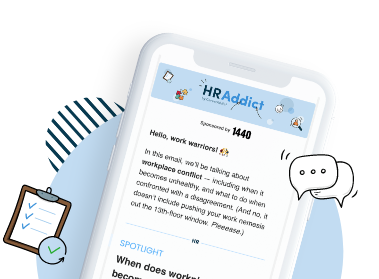This guest post includes sponsored content by Spring Arbor University.
Burnout is the elephant in the break room and the invisible weight in morning meetings. Almost everyone encounters it at least once during their working lifetime. No one is safe, not even people working in the top echelons of organizations.
For HR professionals juggling budget cuts, hybrid work complaints, and company-wide wellness initiatives, burnout can feel inevitable.
What if we looked outside the HR bubble for solutions? Specifically, at a group of professionals who’ve been managing stress and high-stakes decisions long before “quiet quitting” made headlines.
Yep, we’re talking about nurses.
Turns out nurse leaders have developed resilience strategies worth borrowing, and not just in hospitals. Some nurses step into HR leadership roles themselves, armed with MBAs, and bringing fresh, empathy-fueled insights to the table.
TABLE OF CONTENTS
HR isn’t immune to the burnout epidemic
It’s not only nurses who are burning out. HR teams are on the frontlines of a workplace mental health crisis, and it’s catching up fast.
A 2024 Sage report found that 81% of HR leaders are feeling burnt out. It rings closer to home for millennials who, according to Aflac's workforce report, are the generation most likely to experience burnout.
Why? Because HR has evolved. It’s not just payroll and hiring anymore. DEI strategies, trauma-informed care, mental health support, and endless employee feedback loops are part of the job. The emotional labor is real, and it’s time we take the advice we often give others.
And the problem is widespread. The same report from Sage mentions that 95% of HR leaders reported feeling overwhelmed because of excessive workload and stress.
Another survey by Personio revealed that a third of HR professionals are actively considering quitting their jobs due to burnout.
This isn’t a “too much work” issue. It’s become a sustainability crisis. When the people responsible for nurturing workplace culture are running on fumes, everyone suffers.
Emulating nurse leadership: Built-in burnout shields
Nurses have long operated in high-stress, high-impact environments.
Think 12-hour shifts, life-and-death decisions, and emotionally draining interactions, yet they still manage to chart notes legibly.
Needless to say, nurses experienced some of the highest levels of burnout during the COVID-19 pandemic. Yet, many emerged with strategies that HR pros could use right now.
Resilience isn’t a buzzword, it’s a practice
Nurses understand that resilience isn’t something you “have”; it’s something you build.
An MBA for nurses equips nurse leaders to manage a human resources department in healthcare organizations.
Many registered nurses (RNs) tend to take the MBA dual degree program route. They’re taught nursing leadership qualities and business skills to perform nurse administrator roles.
The collegiate nursing education option is recommended for nursing students to advance their careers in business administration or as chief nursing officers. The nursing degree is ideal for nurses with sharp business acumen.
HR takeaway: Embed resilience training into your professional development programs. Start with emotional intelligence assessments and offer resources that help employees (and yourself) build stress-management skills.
Normalize rest without the guilt trip
Nurses are taught to advocate for rest since fatigue can lead to life-threatening errors. In most nursing colleges, students learn that rest is an ethical necessity, not a luxury. Sounds familiar?
HR takeaway: Shift your culture away from “always on.” Encourage true lunch breaks, mental health days, and no-meeting blocks. Set the example by logging off yourself.
Team-based care = team-based work
In hospitals, no nurse is an island. They rely on teams to delegate tasks, provide backup, and offer emotional support. This isn’t just about workflow; it’s about survival.
HR takeaway: Adopt the buddy system for HR teams. Pair junior and senior team members. Use collaborative tools like Slack channels, peer feedback, and shared documentation. These methods reduce silos and create a sense of shared responsibility.
Why more nurses are getting MBAs and what HR can learn
There’s a growing trend of nurses pursuing MBAs to move into leadership, operations, and yes, even HR.
Combining clinical experience with business education equips nurses to lead with both heart and strategy. These hybrid nurse-MBA leaders bring a unique lens to HR challenges. They understand:
- Compassion fatigue and how it mirrors HR burnout
- Systems thinking, which is useful for improving organizational workflows
- People-first leadership, rooted in trauma-informed care
HR takeaway: Consider collaborating with nurse leaders or hiring for crossover roles. Your next HR Director might have an RN suffix in their name.
Borrow these 4 nurse-tested burnout busters
Want to steal (er, borrow) some nurse tricks for your burnout toolkit? Here are four strategies HR teams can adopt today.
1. Shift reports, HR version
Nurses use shift reports to debrief and share important information, almost like passing the baton. HR can adopt this with end-of-week check-ins or debriefs to offload mental clutter and share wins.
2. Color-coded self-care charts
Nurses are big on visual reminders. Some nurse teams use color-coded calendars to track hydration, lunch breaks, and stretch time. HR could use this in the office or on Slack as a friendly reminder system.
3. Micro-restorative breaks
Nursing schools emphasize that short breaks can reset the nervous system. These could be a short walk, quick deep-breathing exercises, or five minutes of journaling.
HR takeaway: Promote “micro-breaks” in your wellness programs. Better yet, block time on calendars so they don’t get skipped.
4. Debriefing rooms or virtual ‘cool down’ zones
Hospitals have quiet debriefing rooms for nurses post-crisis. HR could consider digital or physical spaces for venting, mindfulness, or regrouping after a tough call or meeting.
HR’s burning platform: Why this matters now
As burnout increases, so does turnover, particularly in HR. Burnout problems among leaders can spread like wildfire across industries. Emotional exhaustion leads to critical decision fatigue.
Yet, many HR professionals still feel they can’t talk about it. As people leaders, HR practitioners often feel they must maintain a strong facade, even when they’re struggling.
This culture of silent suffering contributes to long-term disengagement and departure from the profession altogether.
Companies that are serious about retention need to be serious about protecting their HR teams. This means:
- Prioritizing manageable workloads
- Offering mental health resources specifically for HR staff
- Redesigning roles to include strategic recovery time
- Listening to what HR professionals need
The good news? There’s precedent for change. Nurses have been reshaping wellness culture for decades, and their insights are exactly what HR needs now.
The ripple effect
HR teams that successfully integrate lessons from nurse leaders won’t just be helping themselves; they’ll be modeling resilience across the entire organization.
When employees see HR walking the talk, taking breaks, setting boundaries, and using emotional intelligence, they feel empowered to do the same.
This creates a culture of shared wellness. Endurance becomes a value, not a talking point on a wellness poster.
HR also has the power to influence leadership. Advocate for policies that normalize mental healthcare, prioritize people over productivity in times of crisis, and reward rest.
If nurses can show that patient outcomes improve when staff are supported, HR can show it’s the same for business outcomes.
And remember, resilience doesn’t mean pretending things are fine. It means being honest, strategic, and human in the face of pressure. Just like the best nurses, the best HR professionals don’t numb out; they reach out.
Let this be your sign: It’s okay to care for yourself while caring for everyone else. You’re not alone, and you don’t have to do it all. Lean on the wisdom of those who’ve been holding emotional space long before burnout had a hashtag.
Then take a step back, breathe deeply, and lead with empathy. That’s the kind of tenacity the workplace needs.
Building a better future, one boundary at a time
To truly move the needle on burnout, HR must lead the way in redefining what success looks like.
Encourage rest as a metric of performance, embrace flexible work models, and redesign outdated systems that reward overwork.
Think beyond surface-level perks. A ping pong table doesn’t fix chronic exhaustion, but protected quiet hours or access to mindfulness resources might. Follow the nurse model of proactive care, rather than covering problems with reactive band-aids.
Consider starting small: host a resilience-building workshop or set up a feedback loop that’s genuinely safe for employees to share without fear of judgment. These micro-changes will eventually ripple outward.
The most robust organizations are the ones that recognize that productivity and humanity don’t have to be at odds. When HR thrives, everyone does. And that’s a prognosis we can all get behind.
Get inspired, not exhausted
HR isn’t a support function but a strategy driver. You don’t have to white-knuckle your way through each quarter.
If nurses can find ways to survive and thrive under the pressure of life and death literally, surely we can adopt some of their practices to safeguard our well-being.
Next time you’re feeling the HR heat, remember: the answer might be in a stethoscope or a chart. Grab some water. And call your nurse friend for some self-care wisdom—stat.

